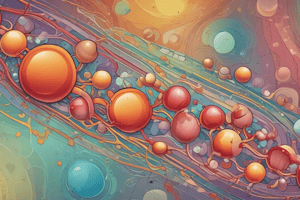Podcast
Questions and Answers
Briefly explain how the mevalonate pathway is significant in the context of steroid hormone synthesis and identify its key precursor.
Briefly explain how the mevalonate pathway is significant in the context of steroid hormone synthesis and identify its key precursor.
The mevalonate pathway is critical because it synthesizes cholesterol, which serves as the precursor for all steroid hormones.
What is the role of an 'acquired' LDL receptor alteration in the context of cholesterol metabolism and potential health implications?
What is the role of an 'acquired' LDL receptor alteration in the context of cholesterol metabolism and potential health implications?
An acquired LDL receptor alteration can impair the clearance of LDL from the bloodstream, leading to increased levels of LDL cholesterol, potentially causing damage to arteries.
If a cell has excessive cholesterol, how is cholesterol synthesis regulated at the level of HMG-CoA reductase, and what class of drugs mimics this regulation?
If a cell has excessive cholesterol, how is cholesterol synthesis regulated at the level of HMG-CoA reductase, and what class of drugs mimics this regulation?
High cholesterol levels inhibit HMG-CoA reductase, reducing cholesterol synthesis. Statins are a class of drugs that mimic this inhibitory effect, lowering blood LDL levels.
Explain the differences between LDL and HDL in terms of cholesterol transport, and indicate which one is considered 'good' and which is considered 'bad' cholesterol.
Explain the differences between LDL and HDL in terms of cholesterol transport, and indicate which one is considered 'good' and which is considered 'bad' cholesterol.
In the context of lipid metabolism, how does the body handle excess carbohydrates in the liver when glycogen stores are full?
In the context of lipid metabolism, how does the body handle excess carbohydrates in the liver when glycogen stores are full?
Describe the role of glucagon in lipid metabolism, contrasting its effects with those of insulin.
Describe the role of glucagon in lipid metabolism, contrasting its effects with those of insulin.
Explain the role of the smooth endoplasmic reticulum (SER) in the synthesis of sphingomyelin.
Explain the role of the smooth endoplasmic reticulum (SER) in the synthesis of sphingomyelin.
Briefly describe the structure of a triacylglycerol (triglyceride) and explain why fatty acids cannot be directly converted into glucose.
Briefly describe the structure of a triacylglycerol (triglyceride) and explain why fatty acids cannot be directly converted into glucose.
Describe the role of 'CO'x' (Cyclooxygenase) in the context of lipid metabolism.
Describe the role of 'CO'x' (Cyclooxygenase) in the context of lipid metabolism.
If a patient has a genetic defect that impairs the breakdown of sphingolipids in lysosomes, what is the likely consequence at the cellular level, and what broader class of diseases does this condition represent?
If a patient has a genetic defect that impairs the breakdown of sphingolipids in lysosomes, what is the likely consequence at the cellular level, and what broader class of diseases does this condition represent?
What distinguishes squalene from cholesterol in the context of steroid hormone synthesis?
What distinguishes squalene from cholesterol in the context of steroid hormone synthesis?
How do omega-3 fatty acids affect lipid metabolism and overall health?
How do omega-3 fatty acids affect lipid metabolism and overall health?
How does the presence of double bonds in fatty acids influence their physical properties and membrane fluidity?
How does the presence of double bonds in fatty acids influence their physical properties and membrane fluidity?
Why is the direct conversion of fatty acids to glucose not possible in animal cells?
Why is the direct conversion of fatty acids to glucose not possible in animal cells?
How does the ratio of insulin to glucagon influence fatty acid metabolism in the liver?
How does the ratio of insulin to glucagon influence fatty acid metabolism in the liver?
How does the structure of sphingomyelin contribute to its function in nerve cells?
How does the structure of sphingomyelin contribute to its function in nerve cells?
What role does NADPH play in lipid metabolism, and where is it primarily generated?
What role does NADPH play in lipid metabolism, and where is it primarily generated?
How does the liver handle excess carbohydrates after glycogen stores are full and energy needs are met?
How does the liver handle excess carbohydrates after glycogen stores are full and energy needs are met?
How do statin drugs lower blood cholesterol levels, and what enzyme do they target?
How do statin drugs lower blood cholesterol levels, and what enzyme do they target?
What is the primary function of LDL receptors, and how is their activity regulated in response to intracellular cholesterol levels?
What is the primary function of LDL receptors, and how is their activity regulated in response to intracellular cholesterol levels?
Which of the following best describes the role of cyclooxygenase (COX) enzymes in lipid metabolism?
Which of the following best describes the role of cyclooxygenase (COX) enzymes in lipid metabolism?
What distinguishes HDL from LDL in terms of composition, function, and health implications?
What distinguishes HDL from LDL in terms of composition, function, and health implications?
What is the function of flippases and floppases in maintaining the lipid bilayer asymmetry, and how do they contribute to cellular processes?
What is the function of flippases and floppases in maintaining the lipid bilayer asymmetry, and how do they contribute to cellular processes?
What is the consequence of a genetic defect that impairs the breakdown of sphingolipids in lysosomes, and what broader class of diseases does this condition represent?
What is the consequence of a genetic defect that impairs the breakdown of sphingolipids in lysosomes, and what broader class of diseases does this condition represent?
What is the significance of diacylglycerol (DAG) in cell signaling, and how is it generated from membrane phospholipids?
What is the significance of diacylglycerol (DAG) in cell signaling, and how is it generated from membrane phospholipids?
Flashcards
Cholesterol
Cholesterol
A precursor to steroid hormones, vital for cell membrane structure and synthesized via the Mevalonate pathway.
COX Enzymes
COX Enzymes
Enzymes involved in converting arachidonic acid into prostaglandins and thromboxanes.
Glucagon
Glucagon
A hormone released by the pancreas that stimulates the breakdown of glycogen in the liver, increasing blood glucose levels.
Insulin
Insulin
Signup and view all the flashcards
Anabolic
Anabolic
Signup and view all the flashcards
Catabolism
Catabolism
Signup and view all the flashcards
Sphingomyelin
Sphingomyelin
Signup and view all the flashcards
Smooth ER Function
Smooth ER Function
Signup and view all the flashcards
HMG-CoA Reductase
HMG-CoA Reductase
Signup and view all the flashcards
HDL Function
HDL Function
Signup and view all the flashcards
Mevalonate Pathway
Mevalonate Pathway
Signup and view all the flashcards
DHA (Docosahexaenoic Acid)
DHA (Docosahexaenoic Acid)
Signup and view all the flashcards
Phospholipids
Phospholipids
Signup and view all the flashcards
Phosphatidic Acid
Phosphatidic Acid
Signup and view all the flashcards
Diacylglycerol (DAG)
Diacylglycerol (DAG)
Signup and view all the flashcards
Glycosphingolipid
Glycosphingolipid
Signup and view all the flashcards
Sulfatide
Sulfatide
Signup and view all the flashcards
Terpenes
Terpenes
Signup and view all the flashcards
Squalene
Squalene
Signup and view all the flashcards
Emulsification
Emulsification
Signup and view all the flashcards
LDL (Low-Density Lipoprotein)
LDL (Low-Density Lipoprotein)
Signup and view all the flashcards
Triglyceride Synthesis
Triglyceride Synthesis
Signup and view all the flashcards
Study Notes
- Lipids Part 2 covers Isoprenoid Structures.
- An objective is for the 3 categories of terpenes, with their naming conventions and examples, to be described.
- The process of cholesterol synthesis should be outlined.
- The basic structure and function regarding sterols should be identified.
Isoprenoids
- Isoprenoids include terpenes, mixed terpenes, and steroids.
Terpenes
- Isoprenoid units are linked together, and are sometimes in alcohol, aldehyde, or ring form.
- Smallest terpene = 2 isoprene units linked together and is a monoterpene.
- Diterpene = 4 isoprenes.
- Triterpene = 6 isoprenes.
- Farnescene = a sesqui terpene.
- Squalene = a triterpene.
- Beta carotene = a tetraterpene.
- Beta-Carotene is used to produce Vit A
- Use.
Mixed Terpenes
- A mixed terpene contains terpenes with a non-terpene component attached.
- CoQ is important in ETC.
- Vit K is active in clotting and formed in the liver.
- Farnesylated proteins support cell signalling
Steroids
- Steroids stem from 6 isoprene units.
- They are made from cholesterol contain four fused rings plus various substituents.
- Along with phospholipids (PLs) it helps to make up most of the cell mass..
Cholesterol
- The liver uses it to make bile for digesting fats (emulsification in the GI tract) and lipoproteins to carry cholesterol to the tissues.
- LDL receptors recognize and bind to LDL to internalize it allowing a cell utilizes the lipids and cholesterol.
- LDL is broken down and cholesterol is released and used to make membranes.
- LDL molecules are relatively small and can pass through a cell membrane.
Familial Hypercholesteremia
- A rare, inherited defect in LDL-receptors often relates to liver/blood LDL-reception due to an inborn error of metabolism.
- Familial Hypercholesteremia leads to high LDL and Cholesterol in liver, so can increases risk of myocardial infarction.
Cholesterol Synthesis
- The four main steps are in the endoplasmic reticulum (ER):
- Condensation of 3 acetyl CoA into mevalonate
- Creation of isoprene units, in forms of isopentenyl pyrophosphates
- Creation of squalene (a triterpene requires 6 isopentenyl pyrophosphates)
- Cyclization of squalene into cholesterol
HMG-CoA Reductase
- The enzyme "HMG-CoA Reductase" is utilized to form an initial HMG-CoA through to initiate Ketogenesis, with 3 Acetyl required. Reductase is necessary to synthesize HMG-CoA during this stage.
- Statins act as an enzyme, having the property of reducing blord bloud LDL.
- The enzyme utilization in the body is under heavy genetic influence. As such it needs to be heavily controlled over either promotion of of inhibitio.
- Inhibited by high intracellular levels of cholesterol, which blocks transcription of HMG-CoA reductase gene.
- Activates if needs be though translation of HMG-CoA to reach a more desired count. This is only implemented should an initial value/count not be acceptable.
Covalent influences
- Elements or functions and cause an the creation of cholesterol/sterol-related properties.
- If is is heavily influenced with various de-phosphorylized elements a synthesis will take will occur to ensure the production of cholesterol.
- This process is assisted ( or influenced, depending on its need) with Insulin, as it can increase the rate or product rate when available for use.
- Glucagon may assist in lowering production, should energy become scarce or low, within the body. In this case, glucose becomes the primary fuel source, at which point triglyceride or steroid production decreases.
Clinical Connection
- Normally, Insulin is released when blood-sugar levels are high, helping move sugar into cells.
- If blood sugar is high over an extended time, cells may stop responding to insulin, causing insulin resistance and elevated insulin blood levels and hyperinsulinemia occurs.
Type 2
- In Type 2 diabetes, resistance to insulin hormone and high blood sugar occur,
- An individual's reaction depends on the body's resistance in insulin absorption
- If blood is sugar high is persistent, with a strong resistance to insulin absorption, increases the risk of cardiovascular disease (and possibly diabetes) due to high LDL levels.
- This potentiality can be reduced though Hormone maintenance, and lowering the bodies hormone resistance.
Isoprenoids
- The main source for steroids starts with in cholesterol itself. The bodies production occurs utilizing specific enzymes to do so, forming most natural sterol-based reactions.
Plant sterols and its derivatives
- Plant sterols have a similar structure to cholesterol and their own membrane-specific properties.
- Plant-derived sterols hinder cholesterol production, while also helping reduce lipid-storage and related disease and lowers LDL levels.
- Cardiac glycosides are derivatives of plant sterols that contain a ringed molecule.
- Glycoside, Digoxin is a cardiac specific with that structure.
Studying That Suits You
Use AI to generate personalized quizzes and flashcards to suit your learning preferences.
Related Documents
Description
Explore lipid metabolism, covering steroid hormone synthesis via the mevalonate pathway and the roles of LDL and HDL in cholesterol transport. Understand how cholesterol synthesis is regulated, the impact of dietary carbohydrates, and hormonal influences. Learn about triacylglycerols and sphingomyelin synthesis.




